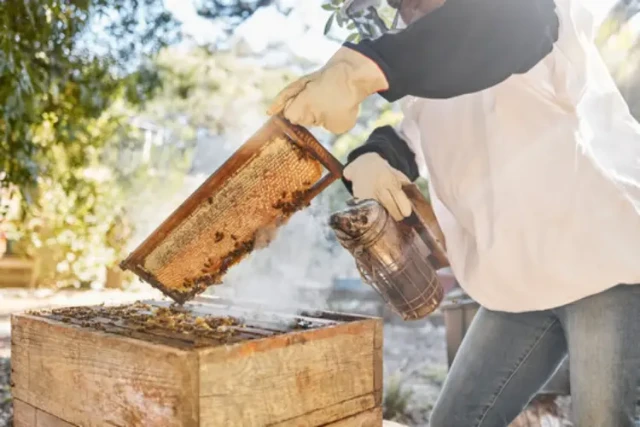For beekeepers, mastering the art of smoking hives is non-negotiable. When used correctly, smoke masks alarm pheromones, reduces defensive behaviors, and creates a safer environment for both bees and beekeepers. But improper technique can backfire—excessive smoke stresses colonies, while insufficient puffing fails to mask critical communication signals. This guide breaks down the science and practical methods to achieve perfect smoke application every time.
The Science Behind Bee Smokers
How Smoke Disrupts Bee Communication
Bees rely on chemical signals (pheromones) to coordinate hive defense. Research shows smoke interferes with their ability to detect these alarms by:
- Masking pheromones: Smoke particles bind to airborne chemical signals, preventing their spread.
- Triggering feeding instincts: Bees interpret smoke as a forest fire threat, prompting them to gorge on honey—a behavior that makes them less aggressive.
Interestingly, smoke doesn’t "calm" bees in the traditional sense. Instead, it creates temporary confusion, buying beekeepers a 10–15 minute window for inspections.
The Role of Fuel Combustion in Smoke Quality
Not all smoke is equal. Ideal fuel burns cool and slow, producing thick, white smoke without sparks or toxins. Key combustion factors include:
| Fuel Type | Burn Temperature | Smoke Density | Safety Notes |
|---|---|---|---|
| Pine needles | Moderate | Medium | Natural resin aids smoldering |
| Burlap | Low | High | Minimal residue, consistent output |
| Wood pellets | High | Variable | Requires moisture to slow burn |
Pro Tip: Avoid synthetic materials or treated woods—they release harmful compounds that contaminate honey and irritate bees.
Mastering Smoker Techniques
Preparing and Lighting the Smoker Safely
- Fuel prep: Loosely pack materials to allow airflow. For pine needles, twist into small bundles; for burlap, tear strips roughly 2 inches wide.
- Ignition: Use a butane torch or crumpled paper to establish a base flame, then add fuel gradually.
- Sustain the burn: Once lit, add denser fuel (e.g., wood chips) to maintain smoke production.
A well-lit smoker should produce smoke for 30+ minutes without needing relighting.
Puff Timing and Patterns for Calming Bees
- Pre-inspection: Apply 2–3 puffs at the hive entrance 1–2 minutes before opening. This gives bees time to react without feeling threatened.
- During work: Lightly smoke frames as you inspect, focusing on areas where bees cluster. Over-smoking causes bees to scatter or become agitated.
- Post-inspection: A final puff encourages bees to reorient to the hive rather than follow you.
Watch for cues: If bees start fanning their wings vigorously, they’re signaling distress—reduce smoke immediately.
Advanced Considerations
Fuel Material Comparisons: Sustainability and Safety
- Pine needles are abundant and free but burn quickly. Best for short inspections.
- Burlap offers superior smoke consistency and is reusable (soak unused portions in water to extinguish).
- Cotton or wood pellets are commercial alternatives but may require additives to sustain combustion.
Eco-note: Locally sourced, untreated materials minimize environmental impact and hive contamination risks.
Avoiding Common Mistakes in Smoke Application
- Over-smoking: Drowning bees in smoke triggers panic, not calm.
- Wrong fuel moisture: Bone-dry fuel burns too fast; soaking-wet fuel creates steam instead of smoke. Aim for slightly damp materials.
- Poor smoker maintenance: Residual tar clogs airflow. Clean with a wire brush after each use.
Ready to upgrade your hive toolkit? HONESTBEE’s commercial-grade smokers and fuel blends help distributors and apiaries manage colonies efficiently—with durable designs that withstand daily use. [Contact us] to explore bulk solutions tailored for your beekeeping operations.
By balancing science with hands-on technique, beekeepers can harness smoke’s benefits while keeping colonies healthy and productive. Remember: The goal isn’t to suppress bees but to work with their natural behaviors for safer, smoother inspections.
Связанные товары
- Оцинкованная пчеловодческая коптильня для медоносной пчелы и пчеловодства
- Нержавеющая сталь улей пчела курильщик пчеловодство курильщик для оптовой
- Профессиональная клеточка для маток с раздвижной заслонкой и пробкой-кормушкой
- Экономика оцинкованные пчеловодство мед пчела курильщик для оптовой
- Коптильня для медовой пчелы из нержавеющей стали Улей и соты для пчеловодства
Связанные статьи
- Основные инструменты пчеловодства: Как стратегическая подготовка повышает здоровье, безопасность и урожайность меда в улье
- Как выбрать и приготовить оптимальное топливо для пчелиных коптилен, чтобы ульи были здоровее
- Как безопасно использовать пчелиный дымарь: успокаиваем ульи без вреда
- Как оптимизировать пчелиный дымарь для более безопасного и эффективного пчеловодства
- Как ухаживать за пчелиной коптильней для оптимальной работы и безопасности




















